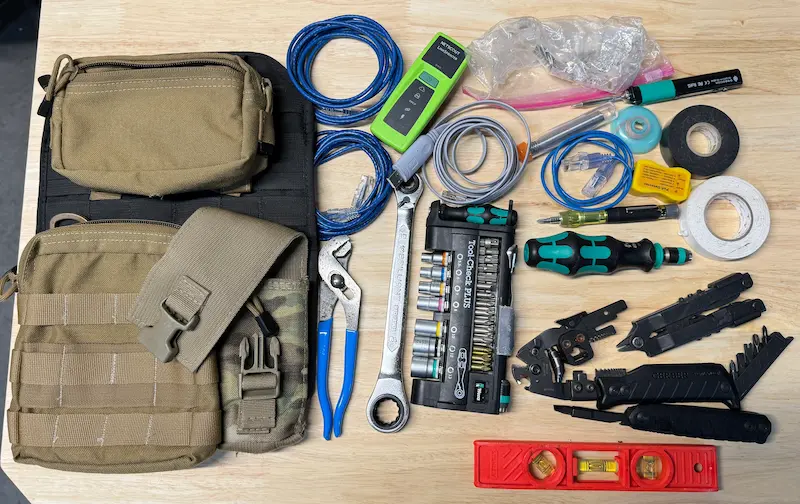Jade's Basic Tech Toolkit
Last summer I taught some classes on fixed wireless networking for disaster response. Most students had a background in IT for NGOs or government, but only a few had experience working for carriers or doing hands-dirty IT in a field environment, so they hadn’t developed a personal toolkit. This led to questions about my toolkit1 and if I had a parts list. Belatedly, this is that list.
Concept
I started carrying what would become this toolkit in 2014 when I was working for an internet provider and needed to carry tools so I could fix poorly terminated ethernet connections or replace network equipment. I needed something that would stay in my work backpack and could be used to solve most of the problems I encountered. I didn’t want a full toolbox because my hands would often be full carrying replacement equipment.
The basic toolkit must contain all tools needed to:
- Make basic repairs to common computer, network, and telephony equipment and infrastructure.
- Install wireless networking equipment.
I’m still not sure if soldering supplies are worth the space & weight. Whenever I haven’t had them, I’ve wished I had. Whenever I have had them, I haven’t used them.
The current (2023) version of my toolkit weighs 2.8kg and measures ~35cm tall, ~24cm wide, and ~10cm deep/thick. I have been using this toolkit since 2019, with a few recent additions such as the soldering iron.
It cannot be an airline carry-on as the multitools contain blades. Also, some airports have confiscated my smaller screwdrivers, so the kit travels in my checked luggage. On the ground, it fits in my deployment2 backpack3 in front of the water bladder pouch.
Hand tools
| Description | Source | Notes |
|---|---|---|
| Small screwdriver, Klein 32614 | Amazon | |
| Larger screwdriver, Wera 051024 | Amazon | |
| Adjustable pliers | local hardware store | |
| 4-way ratchet wrench, BRW75W | Amazon | |
| Multitool, Gerber MP600 | Amazon | |
| Socket/bit set, Wera 056490 | Amazon |
Tech tools
| Description | Source | Notes |
|---|---|---|
| Ethernet cable, 3ft, 28AWG | Monoprice | |
| Ethernet cable, 7ft, 28AWG | Monoprice | 28AWG significantly reduces bulk |
| Cisco console cable, USB | Amazon | |
| PoE Texas’s PoE Detector | Amazon | |
| LinkSprinter | Amazon | |
| Gerber Cable Dawg | Gerber | |
| Soldering iron, USB-C powered | Pine64 |
The PoE Detector has different lights that light up depending on what type of standard or non-standard PoE voltage is present on a cable. This is key when you are working on sites where different incompatible types of PoE are present.
The LinkSprinter is a network tester that you control from your phone or laptop. It can do basic cabling checks and use TDR to detect and measure distance to breaks. It can test PoE. It can check if DHCP is working, if it can reach the internet, etc. This is handy, but it does not precisely substitute for a basic cable continuity tester.
The Gerber Cable Dawg. Like any multitool, it’s not as good at any one thing as a proper task-dedicated tool. The ethernet crimpers don’t ratchet closed. The punchdown doesn’t do spring-loaded impact, etc. But, it replaces multiple similarly sized tools which saves on space and weight.
Consumables
| Description | Source | Notes |
|---|---|---|
| Standard Cat5 connector | ||
| Grounded Cat5 connector | ||
| Electrical tape (black) | Amazon | I prefer 3M Super 88, but other electrical tape works. |
| Electrical tape (alternate color) | Amazon | |
| Solder | Amazon | |
| Desoldering wick | Amazon |
Pouches for organization
The black panel visible in the photo is a CP1 from Triple Aught Design (TAD). It has MOLLE on the front, zipper compartments on the back, and a plastic frame sheet for rigidity.
Unfortunately it looks like TAD has discontinued their line of pouches. You can find similar from other vendors. The general concept of pouches attached to a backing board with zippered compartments remains the same. Whatever you do, I’d proritize having different compartments for different types of tools so you can quickly find a tool without digging through a bag. I’d also pick somehting that doesn’t take up too much space. You won’t always have a spacious workspace where you can unroll a tool roll.
| Description | Source | Notes |
|---|---|---|
| CP1, Triple Aught Design | ||
| GPP1, Triple Aught Design | ||
| GPP2, Triple Aught Design | ||
| Gerber MOLLE holster | For the Cable Dawg via eBay |
I’m thinking about sewing my own organization system to add room for a small digital multimeter.
-
These classes are held in different countries generally outside the US/EU, so we locally source tools to make sure the hands-on portions of class match what they’d actually be using. That said, we all have our own toolkits that we use, which leads to great conversations about tradeoffs and tool preference. ↩︎
-
Deployment, response, whatever. The name iNGOs use to refer to going places and doing things seems to shift periodically to avoid whatever word is in fashion for militaries going places and doing things. ↩︎
-
I use a Mystery Ranch 3DAP CL. ↩︎
